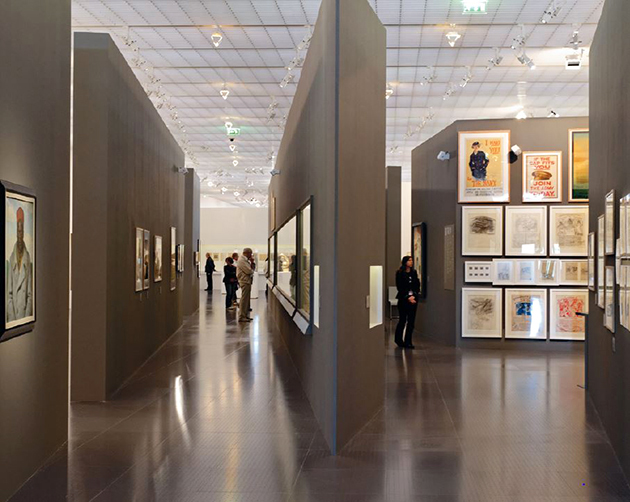A specific Franco-German issue: remembering contemporary conflicts in Alsace-Moselle
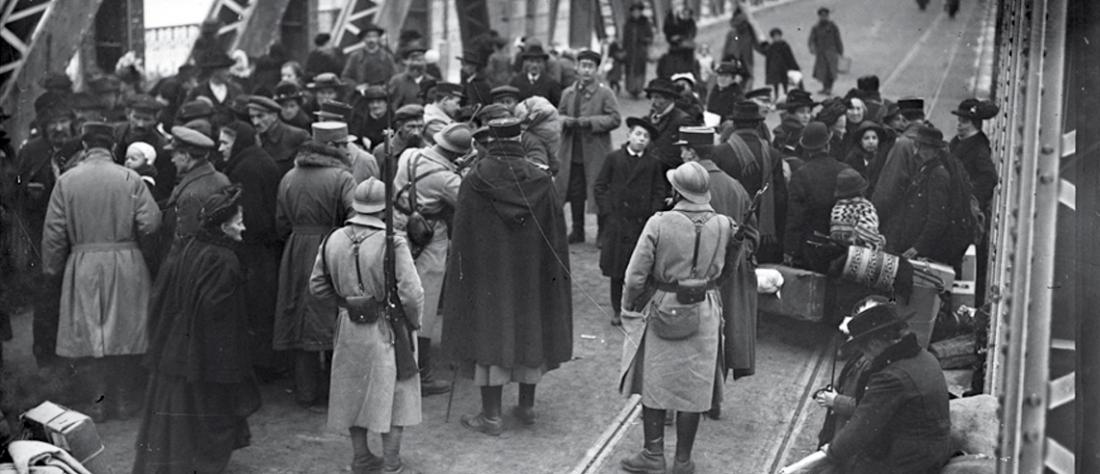
In 75 years, the people of Alsace and Lorraine-Moselle lost four wars (1871, 1918, 1940 and 1945) and yet each time found themselves in the victor’s camp. This sums up the situation of a region on the margins of France and Germany, which was the focus of ongoing disputes between 1870 and 1945. Alsace-Lorraine, later renamed Alsace-Moselle, nevertheless ended up becoming the symbol of reconciliation between the two “hereditary enemies”, in the context of a European Union with one of its capitals in Strasbourg.
A long-term history of “Franco-German” confrontations in Alsace and Lorraine would be fascinating. For instance, Caesar’s victory over Ariovistus at Blaesheim in 58 BC or that of the Viscount of Turenne over the Imperial Army at Turckheim in 1675 were presented after 1870, on the French side, as landmarks in the centuries-long struggle between the Latin and Germanic worlds. If the French emphasised Turenne’s military genius, the Germans stigmatised the atrocities committed by its troops; and the Alsatian separatists made him one of the key protagonists of the “Black Legend” of France – the memorial to Turenne was even the target of a bomb attack in 1980.
As far as the more recent past is concerned, Franco-Prussian War commemorations were long tinged with localism. It was not until the 2000s and 2010s that the conflict began to be remembered from a resolutely Franco-German perspective, by the renovated museum in Woerth, the Musée de la guerre de 1870 et de l’annexion in Gravelotte, the Strasbourg history museum, and the citadels of Bitche and Belfort. The events planned for 2020, however, were severely disrupted by the health crisis. The subsequent period of German annexation (1871-1918) is now accepted in Alsace, where the Neustadt district of Strasbourg was made a UNESCO World Heritage Site in 2017. The region’s military vocation is recalled at the Fort of Mutzig / Feste Kaiser Wilhelm II, thanks to a dynamic organisation that puts the accent on the succession of French and Germans on this site.
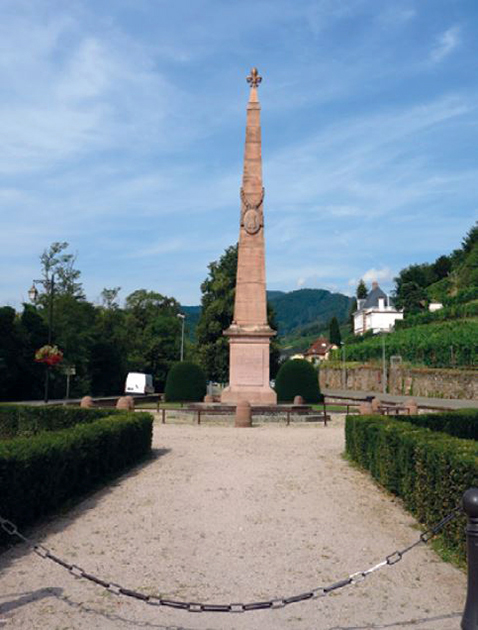
Memorial to the Battle of Turckheim, Alsace. © Rights reserved
Including the “Malgré-Nous” in French remembrancee
Despite the fact that the overwhelming majority of Alsace-Lorraine inhabitants fought on the German side in the First World War, remembrance of the conflict in the region was for a long time exclusively “red, white and blue”. The change of sovereignty was first of all etched in stone: after the German monuments were destroyed and the street names changed, the towns of the former Reichsland were dotted with powerful symbols, like the statue of the Poilu Libérateur in Metz. Franco-Prussian War veterans, French Army volunteers and Francophiles blacklisted by the Germans were the main figures in a “theatre of remembrance” that was staged on 14 July, 1 and 11 November, and on the anniversary of the entry of the liberating troops. Meanwhile, German Army veterans were ignored and made to feel guilty, when they had no alternative but to comply with the law. Thus, the past of most was obliterated, and the choice of a minority was exalted and portrayed as that of the entire country.
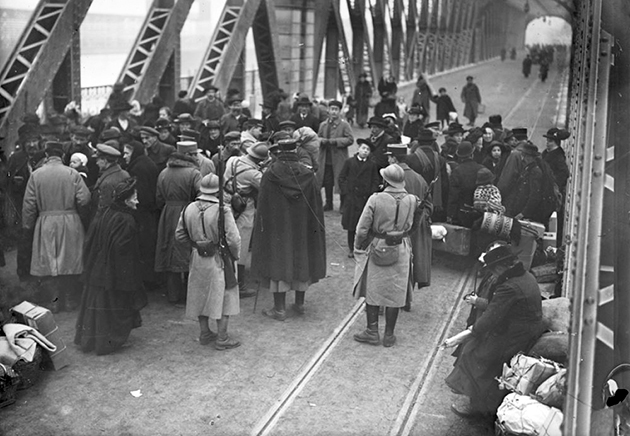
Former soldiers from Alsace-Lorraine, demobbed by the Germans, return home over the Kehl bridge, linking Strasbourg to Baden,
in late November 1918. © Excelsior-L’Équipe/Roger-Viollet
How to pay tribute to sons, brothers and husbands without celebrating their sacrifice for Germany? Local councils all over adopted the same solution: war memorials were Christianised. The religious iconography was neutral and offered an alternative to the Republican symbols chosen in other sites (though there are some nonetheless, which suggests a desire for assimilation). History also explains the absence of the traditional “Mort pour la France”, or “Killed for France” (though there are, once again, exceptions), replaced by neutral wording like “To our dead”. The survivors set up specific organisations, including the “Malgré-Nous”, founded in Metz in 1920, to “bring together all those who, against their will, served under the German flag in the First World War”. This idea of moral constraint – real for some soldiers, imagined for others – became rooted in people’s minds.
The “Alsatian discontent”, and the subsequent independence movement, drew on the dissatisfaction of these veterans in the face of an inept policy of secularisation and excessive Frenchification, and they were secretly supported by Germany. The divergent remembrance of former enemies was difficult to reconcile. And while those on one side at times wallowed in excessive suffering and systematic opposition to central government, those on the other occasionally entertained a far too easily offended nationalism. A counter-remembrance developed, prompted by Alsatians and Lorrainians who were expelled across the Rhine: one of loyalty to Germany, born under Weimar and maintained under the Third Reich by publications and designated sites. It was also one of the extremist fringe of the independence movement, which in 1937 staged the symbolic funeral of “The Most Unknown Soldier”, the Alsatian soldier, at Hunebourg, northern Alsace.
This vengeful spirit triumphed between 1940 and 1944. At Hartmannswillerkopf, as in many communes, the Nazis took out their hatred of Christianity and France on the war memorials. A Nazi veterans’ association was set up in Alsace-Moselle, while the leaders of the French patriotic organisations were persecuted. The authorities insisted conscription should remain as it had been for the previous generation. Recruitment campaigns for the Wehrmacht used posters signed by veterans of the First World War who had enlisted as volunteers in the German Army, like the Alsatian Robert Ernst. After the war, most of the memorials destroyed or altered by the Germans were rebuilt. Meanwhile, all trace of their presence was erased, including the initiatives taken to honour “their” dead, as at Bischwiller.
Towards a binational First World War remembrance
Widespread postwar reconstruction led to the erasure of the memory of the First World War. The 50th anniversary commemorations, in 1968, were a strictly orthodox affair: the liberators were celebrated in a blaze of tricolour flags, despite the official insistence on overcoming national antagonisms in the context of the European Community. Even so, in 1995, when all eyes were on the last remaining survivors, the veterans of the German Army were excluded from the list of recipients of the Légion d’Honneur, awarded by President Chirac to all the surviving poilus.
Exhibition 1917 at the Centre Georges Pompidou, Metz, in 2012. © Marc Feldmann
Since then, First World War remembrance has become widely “binationalised”, not to say “Europeanised”. If the Musée-Mémorial du Linge – run by an independent charity – long refused to include the German combatants who fought in the battle, the Historial franco-allemand du Hartmannswillerkopf, which opened in 2017, did the opposite. The Haute-Alsace Memorial, in Dannemarie, which opened in 2021 in a former munitions factory, adopts even a trinational perspective, given its proximity to kilometre zero and the Swiss border. On 3 August 2014, presidents Hollande and Gauck opened the centenary commemorations on the Hartmannswillerkopf. The Alsace regional authority stood with historians – sponsoring the publication of a book and “centenary talks” which made no mention of German history – and created a “14-18” label giving access to funding. The institutions organised exhibitions: 1917, at the Pompidou Centre in Metz, in 2012; 1914, la mort des poètes [1914, the death of the poets], at the Strasbourg City Library, in 2014-15; and Strasbourg en guerre, 1914-1918. Une ville allemande à l’arrière du front [Strasbourg at war, 1914-18: a German town behind the front], at the City Archives, in 2014-15.
Alongside this “consensual” remembrance, a separatist, Germanophile sensibility still exists. The pro-independence party Unser Land takes advantage of the 11 November ceremonies to denounce what it calls France’s “abduction” of the Alsatian language and history. But this activism should not be allowed to conceal the generally peaceful character of First World War remembrance.
Scattered remembrance of the Second World War
The Second World War is a different matter. The Alsatians and Mosellans who remained in the territory annexed de facto by the Third Reich had experiences that were not shared by the remainder of their compatriots. In particular, they were drafted into the German Army and the Waffen SS, often with the corollary of being captured by the Russians. The Nazi decree of 1942 flouted international law, conscripting all school leavers from 1908 (1914 in Moselle) to 1927, which created a specific category, by far the most numerous (around 100 000 survivors): the “Malgré-Nous” (literally, “despite ourselves” or “against our will”). Yet there were many others, such as those dodging compulsory labour service, the “Malgré-Elles” (female conscripts), expellees, deportees, members of the Resistance and volunteers in the Allied armies, not to mention those mobilised in 1939-40 and civilian victims. Remembrance in Alsace and Moselle, therefore, cannot be anything but plural.
Immediately after the war, relations between the region and the rest of France were founded on incomprehension. In 1953, the Bordeaux-Oradour trial caused lasting discontent. Yet many “annexed” individuals had fought against the totalitarian machine. At the Fort de Queuleu, an organisation preserves the memory of the Mosellan Resistance. A new addition to the French landscape, called for by the departmental and regional authorities, is the Mémorial de l’Alsace-Moselle, Located near the former Nazi “re-education” camp of Schirmeck, the memorial opened in 2005. Its purpose is to “explain Alsace-Moselle” to its population and to anyone who is interested. Quarrels and controversies abound, however, as other “groups” feel neglected compared to the “Malgré-Nous”, in a context of “competition between victims”. Not far away, the Struthof concentration camp, the only one on what was then annexed French soil, is home to the European Centre for Resistance Deportees. The fighting of 1939-40 and the fierce clashes of Liberation also have their places of remembrance.
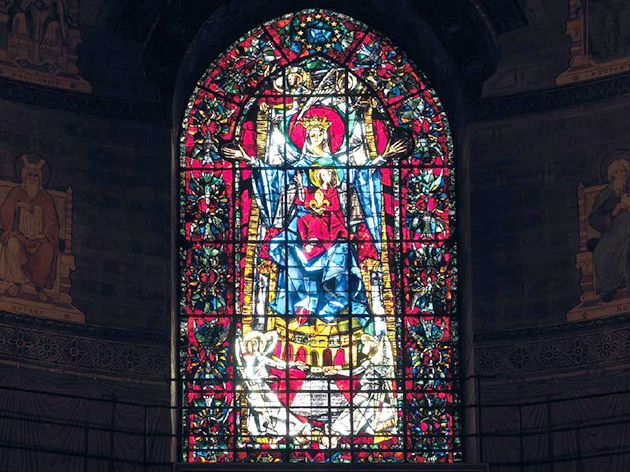
Our Lady of Europe stained-glass window, Strasbourg cathedral. © Chanoine Bernard Eckert
After winning the battle for financial compensation – not until 1984, when the Fondation Entente Franco-Allemande (FEFA) was set up to distribute the money released by the Federal Republic of Germany – the organisations put their energies into obtaining moral recognition: the “Malgré-Nous” no longer wanted to be “shameful soldiers”. Ignored by Jacques Chirac, their request was heard by his successor, Nicolas Sarkozy.
Two declarations – one in Paris, on 11 November 2009, alongside Angela Merkel; the other in Colmar, on 8 May 2010 – appeased a bitterness, in veterans and their friends, often paradoxically more acute towards France, which they claim abandoned them, than towards Germany, which drafted them by force, and the Soviet Union/Russia, which let so many of their comrades die in its camps.
Parallèlement, des associations, comme Ascomémo à Hagondange, ainsi que des historiens, continuent de labourer le terrain, afin de parvenir à une meilleure connaissance de la période. À cet égard, la dimension comparatiste des colloques internationaux organisés à l’initiative d’enseignants-chercheurs et de doctorants de l’Université de Strasbourg, en 2012 à Strasbourg et Schirmeck, L’Incorporation de force dans les territoires annexés au IIIe Reich, et en 2014 à Strasbourg, Soldats d’entre-deux. Identités nationales et loyautés dans les Empires centraux pendant la Première Guerre mondiale, doit être saluée.
Meanwhile, organisations like Ascomémo in Hagondange, and historians, continue their work on the ground, aimed at improving people’s knowledge of the period. In this regard, the comparative aspect of international conferences organised by lecturer-researchers and doctoral students of the University of Strasbourg – in 2012, in Strasbourg and Schirmeck, L’incorporation de force dans les territoires annexés au IIIe Reich (Forced conscription in the territories annexed by the Third Reich), and in 2014, in Strasbourg, Soldats d’entre-deux. Identités nationales et loyautés dans les Empires centraux pendant la Première Guerre mondiale (In-between soldiers: national identities and loyalties in the Central Empires during the First World War) – is to be welcomed.
How to keep a particular memory alive in a republic of Jacobin tradition? The issue of the “Malgré-Nous”, and more recently of the First World War veterans, has at times provided a pretext for identity claims, against a backdrop of discontent caused by globalisation, the crisis of national and European institutions, and changes to administrative boundaries. Yet at the time of the First World War centenary, it was found that most Alsatians and Mosellans now wanted only to remember the young people who died in the prime of their lives, not what uniforms they were wearing. In this, regional opinion follows Western opinion: for a long time now, soldiers have no longer been thought of as heroes of a just cause – and this raises questions – but as victims of the “absurdity” of war. In the choir of Strasbourg cathedral is a stained-glass window depicting Our Lady of Europe, commissioned by Monseigneur Weber, an Alsatian and former French army officer. On 2 August 1964, he celebrated mass on the Hartmannswillerkopf together with the Bishop of Fribourg, as a gesture of reconciliation. Today, the memory of Alsace and Lorraine through the wars has become the bridge between France and Germany which a handful of idealists had dreamed of since the 19th century.


